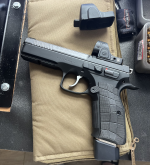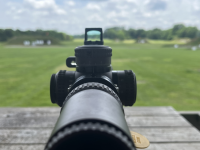Interesting I haven't read that yet. I didn't think the reticle choices were worth an extra $100 but I'll have to read into those other things more.
I plan on disabling the shake awake and prefered no auto adjust brightness. I don't think anyone does auto brightness better than trijicon but want the bigger window of the holosun on this gun. I'm not convinced the rmrcc is that much more robust for a daily carry need.
Yeah to be honest I hadn't read about it anywhere either; I don't know if anyone's bothered to write about it or even look at this point, these K sized optics are still fairly new. I'm just going by what I see in the optics I own. I can try to get some pictures later if it'd help.
You might be able to find a difference in water resistance specs (if any?) that Holosun lists for the 407k vs 507k, which would indicate something about that open emitter window in the 407k.
On the auto brightness - you don't get a choice with either of the "k" optics anyway, but for the standard "c" or RMR size I'd like to share a couple thoughts. Conventional wisdom is that you should use manual brightness, but after carrying an pistol mounted optic of some sort every day for the past 10+ years, I disagree. I think there's a fundamental difference in perspective here, with most (by far) advice on using pistol mounted optics coming from .mil experience, which has then trickled down to LEOs, and then down to civilian trainers. (Granted, these started in the civilian world, and that's where I got into it, but the mainstream thought process has been influenced a lot by the .mil world.)
Thing is, a door kicker military or SWAT type of application is proactive in nature, where one has the luxury of checking, adjusting, and verifying an optic's brightness prior to use. Us ccw guys don't get that luxury - our role is reactive, and the optic has to work everywhere in all conditions, or at least in most conditions you'd reasonably expect to encounter. You don't get to adjust it before using the gun, and although I've heard some guys claim they'll adjust it during the day/night as conditions change, that's unreasonable and not sustainable.
The primary advice I see is to set the optic brightness to work in most conditions. Problem is, that pretty much guarantees that it'll be way too bright in dim light, and likely not bright enough in really bright lighting, like when aiming past/towards really bright lights. (And that scenario is the primary argument against using auto brightness.) You can adjust it brighter so it works well with bright light conditions, but then you've got a blooming lens full of red or green in low light, especially when you've been carrying it all day and there's some lint, dust, etc on the lens.
So my preference, instead of using one fixed brightness, is to use auto brightness. It doesn't work in every single situation, especially with the Holosuns (*more on that in a minute) and mainly when shooting from dark to bright light, but it does work in a much wider range of conditions than fixed brightness. Rather than setting it to not work well at least once per day (too bright or too dim), you get something that works in all except the rare circumstance of shooting from very dark into very bright lighting. And guess what - that's when the irons stand out well anyway, and you can still shoot to those so it's not like you lose ability to aim.
YMMV on that of course, and it's somewhat dependent on the eyes and the optic itself, but for a CCW role please consider whether the recommendations you follow are coming from that same application, or something else. One note on using a fixed brightness optic - I've found that a larger reticle of some sort, either a larger dot, or a circle dot, can be set dimmer than a small dot and still be picked up easily in bright light. I've been experimenting with using a 507k that way with the circle dot (I was previously just using the dot, and didn't like it) and it does seem to be a little better.
*Auto brightness function between the Holosun 507c and Trijicon RMR is different. The Holosun, at least the X2 version, does have two levels of auto brightness (use the higher one), but it uses the solar panel on top as the light sensor. This means that it adjusts brightness based on light directly above the gun. (Test this by covering it with tape or a finger/hand.) The RMR, on the other hand, has the sensor located next to the emitter, behind that tiny glass lens that encloses the emitter and makes it water resistant. Because of the location, the light sensor "sees" brightness in front of the gun; it's not pointed exactly where the gun is pointed, but up at a slight angle. That's not perfect, but is a much better auto brightness system than the Holosun, and in most conditions even shooting from dark to bright it still adjusts correctly. Exceptions are when something above you shadows the light the sensor sees, like aiming upwards through a doorway so that the top of the doorway shadows the optic (but again that's partly why we use co-witnessed irons). I do not have an RMRcc and don't know if it works the same way, but it's a different and much longer footprint than the "k" sized Holosuns. Currently the only "k" sized optic with auto brightness I know of is the Swampfox Sentinel, but its light sensor is on the side, and they're not known to be very robust; I wouldn't carry one.
Anyway, that's a lot more than I intended to type out, but hopefully some food for thought at least.



